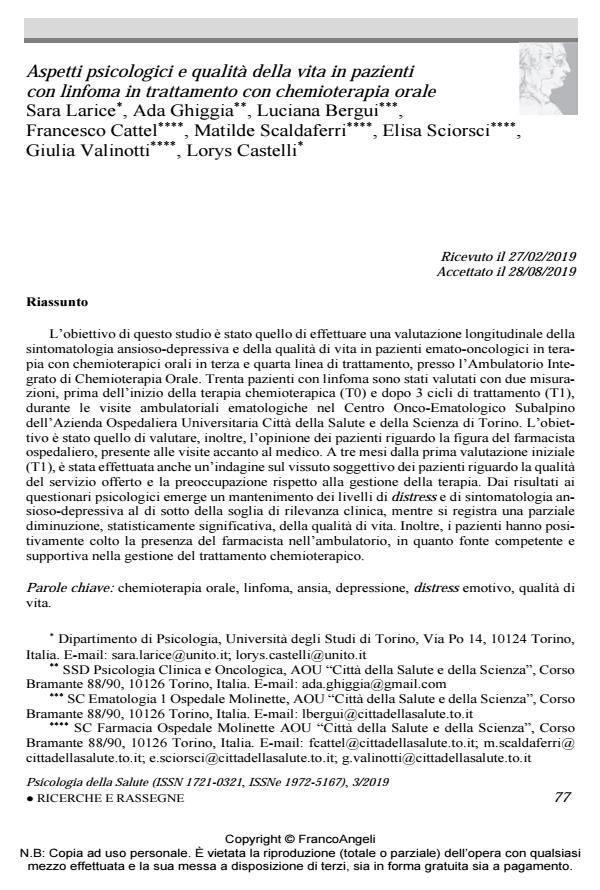Aspetti psicologici e qualità della vita in pazienti con linfoma in trattamento con chemioterapia orale
Titolo Rivista PSICOLOGIA DELLA SALUTE
Autori/Curatori Sara Larice, Ada Ghiggia, Luciana Bergui, Francesco Cattel, Matilde Scaldaferri, Elisa Sciorsci, Giulia Valinotti, Lorys Castelli
Anno di pubblicazione 2019 Fascicolo 2019/3
Lingua Italiano Numero pagine 21 P. 77-97 Dimensione file 299 KB
DOI 10.3280/PDS2019-003005
Il DOI è il codice a barre della proprietà intellettuale: per saperne di più
clicca qui
Qui sotto puoi vedere in anteprima la prima pagina di questo articolo.
Se questo articolo ti interessa, lo puoi acquistare (e scaricare in formato pdf) seguendo le facili indicazioni per acquistare il download credit. Acquista Download Credits per scaricare questo Articolo in formato PDF

FrancoAngeli è membro della Publishers International Linking Association, Inc (PILA)associazione indipendente e non profit per facilitare (attraverso i servizi tecnologici implementati da CrossRef.org) l’accesso degli studiosi ai contenuti digitali nelle pubblicazioni professionali e scientifiche
L’obiettivo di questo studio è stato quello di effettuare una valutazione longitudinale della sintomatologia ansioso-depressiva e della qualità di vita in pazienti emato-oncologici in terapia con chemioterapici orali in terza e quarta linea di trattamento, presso l’Ambulatorio Integrato di Chemioterapia Orale. Trenta pazienti con linfoma sono stati valutati con due misurazioni, pri-ma dell’inizio della terapia chemioterapica (T0) e dopo 3 cicli di trattamento (T1), durante le visite ambulatoriali ematologiche nel Centro Onco-Ematologico Subalpino dell’Azienda Ospedaliera Universitaria Città della Salute e della Scienza di Torino. L’obiettivo è stato quello di valutare, inoltre, l’opinione dei pazienti riguardo la figura del farmacista ospedaliero, presente alle visite accanto al medico. A tre mesi dalla prima valutazione iniziale (T1), è stata effettuata anche un’indagine sul vissuto soggettivo dei pazienti riguardo la qualità del servizio offerto e la preoccupazione rispetto alla gestione della terapia. Dai risultati ai questionari psicologici emerge un mantenimento dei livelli di distress e di sintomatologia ansioso-depressiva al di sot-to della soglia di rilevanza clinica, mentre si registra una parziale diminuzione, statisticamente significativa, della qualità di vita. Inoltre, i pazienti hanno positivamente colto la presenza del farmacista nell’ambulatorio, in quanto fonte competente e supportiva nella gestione del trattamento chemioterapico.
Parole chiave:Chemioterapia orale, linfoma, ansia, depressione, distress emotivo, qualità di vita.
Sara Larice, Ada Ghiggia, Luciana Bergui, Francesco Cattel, Matilde Scaldaferri, Elisa Sciorsci, Giulia Valinotti, Lorys Castelli, Aspetti psicologici e qualità della vita in pazienti con linfoma in trattamento con chemioterapia orale in "PSICOLOGIA DELLA SALUTE" 3/2019, pp 77-97, DOI: 10.3280/PDS2019-003005